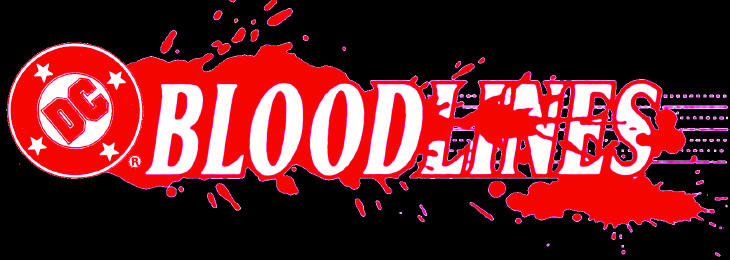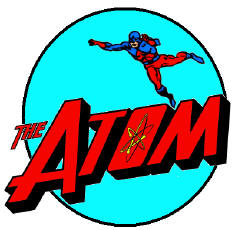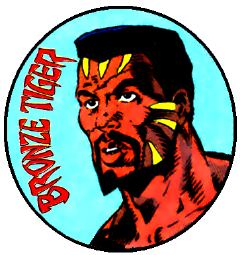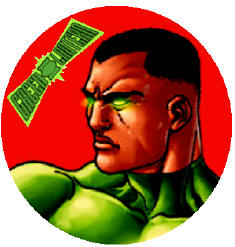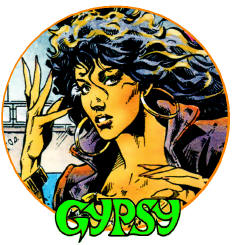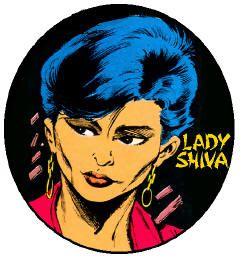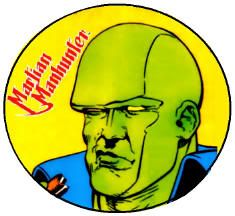Autumn arrives with
September of 1985.
Balder the Brave had a strong house ad presence, but when the first issue hit the stands, I had no interest whatsoever. I talked about tossing through the first issue of Continuity Comics'
Armor series at the mall bookstore, as well as other experiences with that company, in a series of podcasts on another of my Four Color Rolled Spine solo shows, Amazing Heroes. Suffice to say that as cool as the cover was, the titular star's absence from all but 5 story pages in a book that cost nearly as much as three mainstream super-hero comics meant it didn't come home with me until decades later.
A chronology-challenged title was Bissette & Veitch's
Bedlam #1, an Eclipse Comic that I fished out of the quarter bin in '89. It was a two-issue reprint anthology covering darkly humorous and horrific tales for various publishers dating back to the '70s. The final story featured a black man trapped in an unusual prison who grinds his fingertips to the bone and is forced to consume his own waste, among other disgusting turns. That one traumatized me, or else I wouldn't have bothered bringing this one up. The Gladiator story in
Daredevil #226 was drawn from a quarter bin so late that it's probably disqualifying, sometime between 1989 and 1991 I figure, and leaving no great impression. You may be surprised to hear that despite Flag Smasher eventually become one of my favorite Cap villains, I did not actually buy his debut in
Captain America #312. I just gave it a real hard looking at on the stand. Also pretty much missed
X-Men/Alpha Flight and
New Mutants Special Edition. My half-brother may have had them, but I never committed to reading his copies.
Heroes for Hope: Starring the X-Men was something my brother would buy a few years down the line. Much like Texas, everything was bigger in the eighties. As much as they're maligned for conspicuous consumption, the '80s also went hard on charity drives. Marvel put everything they had into aiding famine relief in Ethiopia, ironically bringing a murderers row of talent and offering up the money printing press that was their mutant heroes. Starting with a group shot showcasing Wolverine by Arthur Adams, this special offers Brian Bolland, John Byrne, Frank Miller, John Bolton, Steve Rude, Paul Gulacy, Richard Corben, John Romita Jr, and many more, with pages scripted by Stephen King, George R.R. Martin, Alan Moore, Harlan Ellison, Chris Claremont, and yes, even Stan Lee. It's a decent story, with striking moments of horror. Jim Starlin and Berni Wrightson were the Bob Geldoffs of this affair, and as with Do They Know It's Christmas and We Are The World, there was a fair amount of talent double-dipping when they convinced DC Comics to do their own Heroes Against Hunger the following year. Not to pit two charity efforts against one another, but I think Ethiopia is doing a lot better these days, which I can't say for DC's lackluster attempt. Besides a nigh-iconic Neal Adams cover,
Heroes Against Hunger unintentionally illustrates the disparity between Marvel and DC in the peri-Crisis era. The tired story has Superman and Batman battling space aliens and power suit Lex Luthor. Both projects feature work by Gray Morrow, Mike Kaluta, Jeff Jones, Howard Chaykin and others, but often they switch from pencils to inks, or are saddled with lesser inkers on the second pass. Kim DeMulder proves to be among George Perez's worst inkers, and Perez himself offers a possible career low splash page of a tiny Superman carrying a very big green box offer a rather sparse desert. GL & Ordway, Gibbons & Patterson, and Kubert & Rubenstein combine for some of the book's best pages, but they're surrounded by well-intentioned semi-retirees like Jack Kirby, Curt Swan, Carmnine Infantino, and Ross Andru. BWS, Keith Giffen, Ed Barreto, Dan Jurgens, Dave Ross, and Jim Sherman are all thwarted by poorly chosen embellishers. There are no big swings in the writing department: just the guys and a pair of gals that you would expect on a DC title in 1986. Probably because of the charity nature, or a nightmare royalty split, neither of these charity books have ever been reprinted. A rare missed opportunity for Marvel, and a bullet dodged for DC.
I'm still dubious about
Longshot #4 shipping this month. I recall a big gap between #3-4, and #4 may have been my first chance to pass on it at my newsstand, rather than being entirely dependent on my brother's copies. This was also where the story started losing me, with its forced She-Hulk and Spider-Man guest appearances, weird Ronnie Reagan analogue, advancing subplots, and back story lore overshadowing the main character's narrative. Looked glorious though, and whatever evolution Arthur Adams has made as an illustrator, it's tough to compete with his youthful enthusiasm for drawing all the lines on every possible thing.
Marvel Saga: the Official History of the Marvel Universe #1 was a solid supplement to OHOTMU. Marvel was big on giveaway comics in the aughts and 20-teens called "Blank" Saga where they'd give an illustrated overview of a property's history using recycled art and text paragraphs. They got their branding from this comic. After a few pages of covering the history of the cosmos in huge swaths, the title settles into a chronological recap of the Marvel canon circa Fantastic Four #1. Retcons are incorporated, so after forcing '80s kids to tolerate many pages of phoned-in Kirby, they get their John Byrne dessert with James McDonald Hudson developing the Guardian suit, all blessed by Wolverine appearances. Not being a Silver Age comics fan, this title was hugely important in imparting to me all that early Marvel history second-hand, and this I did read cover-to-cover.
Rod Whigham is probably nobody's favorite artist, and he's ghostly paler compared to the Mike Zeck covers, but I was sure glad to see him draw books like G.I. Joe a Real American Hero #42 when the alternative was patients out of the comic book artist nursing home. This one continued the Billy subplot, a.k.a. Cobra Commander's Damian Wayne, now joined with fan favorite evil ninja Storm Shadow. Good stuff.
Fist of Khonshu: Moon Knight #6 was another late '80s Marauder Comics quarter buy. It gets a pass because it's an Afro-centric story written by the future Christopher Priest, drawn by Mark Beachum, inked by Geoff Isherwood, with a painted Bill Sienkiewicz cover. I still have the same copy, because it's just too pretty to ever let go of. I got into Moon Knight with my buddy's grocery sack o' comics, basically swiping them and atoning by opening up my collection to him for forced trades. Even with the TV show, I'm confident he came out better in the deal, though I still feel bad about it. This could have pretty easily been a Daredevil story, but there's a voodoo angle that tilts it in Marc Spectre's favor, and it is one of the better efforts to live up to the often unfulfilled promise of that wicked character design. This may be redundant, but the Beachum art is sexy.
I'm sure that I made it to
Nightcrawler #2, possibly aided by the Kitty Pryde cameo, but I drew the line at the promised appearance next issue of Bamf, sort of Kurt Wagner's Muppet Baby equivalent. There was just way to much fantasy swashbuckling and flying pirate ships for my liking. I wasn't completely off the Dave Cockrum train yet, but he was starting to remind me to much of the long-in-the-tooth Superman artists of the day with his stiffness.
Uncanny X-Men #200 was $1.25, and instead of Wolverine fighting a knife-wielding Warpath on the cover, it was bad temporary purple-costume Magneto on trial for killing a submarine full of Russian soldiers years earlier. As with lawyers, that just sounds like a good start to me. I let my brother buy this one and read it later. I was intrigued by the couple of pages plainly ghost-illustrated by Jim Starlin, almost certainly related to the Heroes for Hope project, but this was never a favorite of mine.
Peter Parker, the Spectacular Spider-Man #109's stark cover demands your eyeballs, even if the insides are rather "middle chapter." There's a Santa Claus subplot that I won't follow up on, more Daredevil to acknowledge the Daredevilness of the not-so-new but kinda-daring for the Webhead direction, plus a fake-out imperiling a long time supporting character. This one would eventually get tied up into Venom's origin, but I prefer it as a young Peter David set on sincere grim & grittiness, without any puns intruding.
I was still showing up for
Blue Devil with #19, even if it was months late to a flea market booth for a discounted copy. Also, a Kid Devil solo story, featuring the Jason Todd Robin from when he was still a Dick Grayson clone. Actually, skimming through a book I doubt I've read in over 35 years, these are probably all imaginary sequences, so if this was my first Captain Cold story, I guess it wouldn't count as such. I didn't skip the following month on account of all that, but it did skip me, so I went without regardless of any intentions on my part.
Official Handbook of the Marvel Universe #2 will wrap up September of 1986, and maybe this podcast. Like I said at the top, I drafted most of the August script in January, but sidelined the show to focus on more pressing podcast matters. I'm currently on page 6 of the total draft, so if I want to keep this episode in the half-hour range, I better start working my way to the door. This issue had a Byrne Cap on the cover and a Zeck one for the entry, so a no-brainer purchase. Starting with a Kerry Gamnmill Beast couldn't have hurt. Captain Ultra stood out as Mort of the Month years before Wizard Magazine articulated that sentiment, maybe even presenting Captain Ultra as platonic ideal of unideal characters in their first reference to the dishonor.
